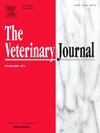清醒和麻醉犬静脉注射氨苄西林的群体药代动力学。
IF 3.1
2区 农林科学
Q1 VETERINARY SCIENCES
引用次数: 0
摘要
本研究的目的是描述清醒和麻醉犬在这两种治疗方案下静脉注射氨苄西林-舒巴坦的群体药代动力学模型,并计算PK/PD截断值(PK/PDCO)。这是一项前瞻性临床试验,在20只客户拥有的狗中,要么在术后感染后接受氨苄青霉素治疗,要么在手术抗菌预防的背景下进行治疗。所有动物均缓慢静脉注射氨苄西林20mg/kg。麻醉时按标准建议每90min给药一次氨苄西林,清醒时每8h给药一次氨苄西林。双区隔模型最好地描述了这些数据。麻醉和给药时血肌酐浓度与氨苄西林清除率相关,清醒时为318±36ml/kg/h,麻醉时为186±12ml/kg/h。蒙特卡罗模拟表明,在清醒犬中,每8h 20mg/kg,当目标为40%fT>MIC时,PK/PDCO为0.5mg/L;当目标为50% fT>MIC时,PK/PDCO为0.25mg/L。每8小时延长输注氨苄西林(4h),使PK/PDCO分别达到4mg/L和2mg/L,目标为40%和50%。在麻醉动物中,每90min重复使用20mg/kg氨苄西林,使其在100%的时间内保持在4mg/L以上。在客户拥有的狗中,氨苄西林的血浆清除率与血浆肌酐浓度呈负相关,并且在麻醉期间降低约40%。在清醒犬中,静脉给药20mg/kg / 8h的标准方案可能不足以治疗革兰氏阴性菌引起的软组织感染。延长输注时间有助于提高氨苄西林对特定病原体的疗效。本文章由计算机程序翻译,如有差异,请以英文原文为准。
Population pharmacokinetics of intravenous ampicillin in awake and anesthetised dogs
The aim of this study is to describe a population pharmacokinetic model for intravenous ampicillin-sulbactam in awake and anaesthetized dogs in these two treatment scenarios and to compute PK/PD cut-offs (PK/PDCO).
This was a prospective clinical trial in 20 client-owned dogs, either treated by ampicillin after post-surgical infection, or in the context of surgical antimicrobial prophylaxis. All animals received 20 mg/kg of ampicillin by slow iv route. During anesthesia ampicillin administration was repeated every 90 min according to standard recommendations, whereas in awake animals, ampicillin administration was every 8 h. A bi-compartmental model best described the data. Anesthesia and creatinine plasma concentration at the administration correlated with ampicillin clearance, which was 318 ± 36 ml/kg/h in awake animals and 186 ± 12 ml/kg/h in anesthetized animals. Monte-Carlo simulation showed that 20 mg/kg every 8 h in awake dogs led to PK/PDCO of 0.5 mg/L using a target of 40 %fT>MIC and 0.25 mg/L with 50 % fT>MIC. Administration of ampicillin by prolonged infusion (4 h) every 8 h allowed to achieve a PK/PDCO of 4 mg/L and 2 mg/L with the 40 % and 50 % targets, respectively. In anesthetized animals, repetition of the 20 mg/kg of ampicillin every 90 min allowed to remain above 4 mg/L during 100 % of the time.
Plasma clearance of ampicillin inversely correlates with creatinine plasma concentration in client-owned dogs and is reduced of about 40 % during anesthesia. In awake dogs, the standard regimen of 20 mg/kg every 8 h by intravenous route is probably insufficient to treat soft tissues infections caused by gram-negative bacteria. Using prolonged infusion could help to increase ampicillin efficacy against specific pathogens.
求助全文
通过发布文献求助,成功后即可免费获取论文全文。
去求助
来源期刊

Veterinary journal
农林科学-兽医学
CiteScore
4.10
自引率
4.50%
发文量
79
审稿时长
40 days
期刊介绍:
The Veterinary Journal (established 1875) publishes worldwide contributions on all aspects of veterinary science and its related subjects. It provides regular book reviews and a short communications section. The journal regularly commissions topical reviews and commentaries on features of major importance. Research areas include infectious diseases, applied biochemistry, parasitology, endocrinology, microbiology, immunology, pathology, pharmacology, physiology, molecular biology, immunogenetics, surgery, ophthalmology, dermatology and oncology.
 求助内容:
求助内容: 应助结果提醒方式:
应助结果提醒方式:


